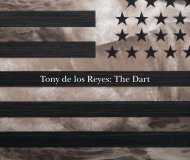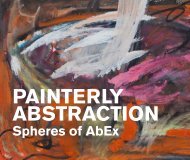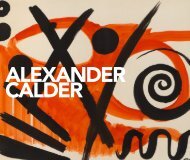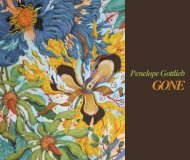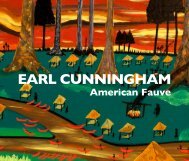Untitled - Heather James Fine Art
Untitled - Heather James Fine Art
Untitled - Heather James Fine Art
- No tags were found...
You also want an ePaper? Increase the reach of your titles
YUMPU automatically turns print PDFs into web optimized ePapers that Google loves.
Embroidery of a Floral and Bird MotifChina, 19th CenturySilk10 x 7 ft.AS1021The peacock is the symbol of beauty and dignity, while the pheasant is also the symbol of beauty as well as good fortune. The art ofembroidery is a long established art form; it became widespread during the Han Dynasty (206 B.C.-220 A.D.). Men and women were bothinvolved in working on the fine silk embroideries. Some of the exquisite, finely stitched embroideries took 5 to 6 people and several yearsto complete. The finest embroidery pieces were very expensive. Gradually, embroidery developed as a pastime for the Imperial Palacecourt women and many members of the court were renowned for their intricate needlework.
Oil Lamp of a RamChina, Han Dynasty (206 BC - 220 AD)Painted PotteryLength: 15 in.2482During the Han Dynasty burial rituals became increasingly complex and hierarchical. Burial mounds formed the shape of hills, a referenceto the belief that the dead made their homes on mountains. Symbolism was also more defined with the ‘Five Elements’ playing anincreasingly important role. Comprised of the four cardinal directions with earth at the centre representing equilibrium, each point wasassociated with different animals, seasons, colours and properties. Funerary wares from the Han period provide a fascinating insightinto the nature of daily life. There are replicas of complete farms with granaries, animal pens and domestic dwellings. Aristocratic tombsalso contained substantial terracotta and wooden figures which attested to the status and power of the deceased, such as sculptures ofwarriors and their chariots, foot soldiers, grain stores and horses.
Oil Lamp of a StagChina, Han Dynasty (206 BC - 220 AD)Painted PotteryLength: 15 in.2483During the Han Dynasty burial rituals became increasingly complex and hierarchical. Burial mounds formed the shape of hills, a referenceto the belief that the dead made their homes on mountains. Symbolism was also more defined with the ‘Five Elements’ playing anincreasingly important role. Comprised of the four cardinal directions with earth at the centre representing equilibrium, each point wasassociated with different animals, seasons, colours and properties. Funerary wares from the Han period provide a fascinating insightinto the nature of daily life. There are replicas of complete farms with granaries, animal pens and domestic dwellings. Aristocratic tombsalso contained substantial terracotta and wooden figures which attested to the status and power of the deceased, such as sculptures ofwarriors and their chariots, foot soldiers, grain stores and horses.
Hu with a ChainChina, Zhou Dynasty (1122 – 256 BC)BronzeHeight: 12 1/2 in.AS780The hu is a ritual wine vessel used with other ritual vessels in temple offerings of food and wine to ancestors and placed in tombs and burialsites to honor the dead. This slender, curved, pear-shaped bottle is made of bronze. Given the relatively restrained decoration of this hu, itis therefore instead probably related to the generally more austere style found in regions of Northern China, although austerity was by nomeans incompatible with magnificence. Such large bronze vessels were also symbols of power and status. In fact, early Chinese historicaltexts state that the possession of hu vessels symbolized the authority to rule. Hu with suspension chains appeared in the 6th century BCE,apparently inspired by nomadic lifestyle. The hu is one of the last models of bronze wine vessels. These were soon to be replaced bypolychrome pottery hu that were both cheaper and more suitable for use as funerary artifacts to replace the obsolete ritual bronze vessels.
Scholars RockChina, 19th CenturyYing stone17 1/2 x 7 x 11 1/2 in.3725The term “scholar’s rock” is used to describe rocks of a distinctive shape, texture, and color that were deemed appropriate for display inthe scholar’s studio. Rocks have long been admired in China as an essential element in gardens. By the early Song dynasty (960–1279),small ornamental rocks were also collected as accoutrements of the scholar’s study, and the portrayal of individual rocks—often joinedwith an old tree or bamboo—became a favorite and enduring pictorial genre. From the fourteenth century onward, depictions of gardensalmost always included representations of a fantastic rock or “artificial mountain,” and scholars’ rocks often supplanted actual scenery assources of inspiration for images of landscape.
Japan
Ando Hiroshge (1797-1858)Mount Atago ShibaOne Hundred Famous Views of EdoJapan, 1857Woodblock Print13 1/4 in. x 8 3/4 in.2001Ando Hiroshige was a famous Japanese painter and printmaker who was the last great figure in the art of Ukiyo-e, which literally means“pictures of the floating world”. Hiroshige transmuted everyday landscapes into intimate, lyrical scenes with aesthetics that highlighted thetransient nature of existence. Woodblock prints became very fashionable in Europe in the 1860’s and 1970’s and had a direct impact onMonet and the Impressionists, as well as Gauguin and van Gogh.
Ando Hiroshge (1797-1858)BuzenFamous Views of Sixty Odd ProvincesJapan, 1854Woodblock Print13 1/4 in. x 8 3/4 in.2005
Ando Hiroshge (1797-1858)Zenko Temple and the Ferry at KawaguchiOne Hundred Famous Views of EdoJapan, 1857Woodblock Print13 1/4 in. x 8 3/4 in.2009
Ando Hiroshge (1797-1858)Aoi SlopeOne Hundred Famous Views of EdoJapan, 1857Woodblock Print13 1/4 in. x 8 3/4 in.2011
Embroidered Roundels of TurtlesJapan, 19th CenturySilk and Gold Thread Embroidery21 x 32 in.2138 / AS 1985Japan’s textile industry was one of the first to adopt Western science and technology, and thus the Meiji era produced some of the highestquality silk textiles. The engravings of oil paintings inspired the embroideries, with the artist of the painting and the artist at the textilefactory maintaining a close relationship. Japanese embroidery technique goes back more than one thousand years. It originated in Chinaand was eventually introduced to Japan by Korean artisans; around the same time Buddhism entered Japan. In Japan, colored silkswere embroidered with long soft stitches in untwisted silk threads. Flowers, birds, bold flowing lines, and abstract motifs are common inJapanese textiles, and the designs achieve a feeling of calm restraint through their spacious distribution. Also characteristic of Japanesetextiles is the use of gold and silver thread. The Japanese developed a special method of creating metal threads, in which a layer of goldor silver was deposited on to rice paper, which was then cut into fine strips and wrapped around a thread core.
Fukusa of a Fan Motif with Cranes and TortoisesJapan, Meiji Period, (1868-1912)Silk Emboidery36 x 36 in.2185 / AS 1168The practice of laying fukusa over presents placed on wooden or lacquer trays becamewide spread during the Edo period, (17th to 19thcentury). What begun as a functionalpractice to protect gifts from the elements, took on a decorative life of its own. Well to do familiesowned large numbers of fukusa and often, commissioned famous artists of the time to design exclusively for them. The drawings were thencreated by such techniques as tie-dying, stenciling, slit embroidery, tapestry, painting with embroidery and combinations of all methods.Each time a fukusa was required, it was chosen not only for the occasion but also for the season, the gift itself, and status of the donorand the recipient.
Fukusa of Dignitary on Horseback with AttendantsJapan, Meiji Period, (1868-1912)Silk Emboidery37 x 34 1/2 in.2443 / AS1186
Fukusa of Scholars with ScrollJapan, Meiji Period, (1868-1912)Couched gold and silk floss on blue silk ground2443 / AS1186
Fukusa of Tortoise and CraneJapan, Meiji Period, (1868-1912)Silk and gold thread emboidery34 x 36 in.AS1194
EagleJapan, Meiji Period (1868-1912)Silk and Gold Thread Embroidery82 x 56 in.3218The Meiji era produced some of the highest quality silk textiles. The engravings of oil paintings inspired the embroideries, with the artistof the painting and the artist at the textile factory maintaining a close relationship. Japanese embroidery technique goes back more thanone thousand years. It originated in China and was eventually introduced to Japan by Korean artisans; around the same time Buddhismentered Japan. The Emperor Meiji, who replaced the last shogun Tokugawa Yoshinobu as Head of State, was a man of vision and culture.He encouraged the adoption of Western customs, fashion, education and industry, and above all the continuation of the traditional artsand crafts of Japan in a form adapted to world-wide taste and expectation. In 1890 he instituted a system of honorific appointments tothe Imperial Household called the Teishitsu Geigei-In or “Imperial <strong>Art</strong>ists”. These elite artists were commissioned to make pieces forpresentation to both Japanese and foreign dignitaries and had the right to mark them with the chrysanthemum Mon, or badge, of theImperial Family.
Dragon scrollJapan, Meiji Period (1868-1912)Silver thread and silk embroidery56 x 27 1/4 in.4987
Embroidery of Birds and IrisesJapan, Meiji Period (c.1890)Silk embroidery30 x 30 in.AS887
Eagle on a Pine BranchJapan, Meiji Period (1868-1912)Silk embroidery63 1/4 x 26 1/2 in. (each panel, framed)2792
Swirling DragonsJapan, Meiji Period (1868-1912)Silk embroidery3866
Floral EmbroideryJapan, Meiji Period, c. 1900Silk floss and satin stitch64 x 59 in.5048
Scroll Painting of a White HawkJapan, Edo Period (1603-1868)Pigment on Paper76 in. x 25 in.2317 / AS 578As nearly all forms of art, early painting had been under the influence of the Chinese culture. By and by, new and specifically Japanesestyles were developed and painting schools were established. Each school practiced their own style. However, Chinese influence remainedstrong until the beginning of the Edo period (1603-1867). There is a general term to describe painting in the Japanese style - yamato-e.After the opening of Japan to the West under the Meiji period (1868-1912), the early years were marked by an exaggerated embracing ofWestern art. The newly founded universities established departments for Western art, called Western academic artists into the country asteachers and sent out students to study art in Europe - mainly in France and Italy. Hand in hand with a rising nationalism, the pendulumsoon went back into the other direction. The public opinion began to recognize the richness of the old tradition and even condemnedWestern art.
Six-Panel Screen of PheasantsJapan, Edo Period (1603-1868)AS 924The folding screen byobu is one of the distinctive forms of Japanese art. As is true of much of Japanese culture, thebyobu originated in China and was adopted by Japan in the Eighth Century. By the Momoyama period (1568-1615),stylistic and technical changes led to screens becoming the focal point of domestic spaces. Often, but not always,screens were created in pairs and were made of two, four, six and on occasion 8 panels. Two-panel screens usuallymeasure three feet wide by six feet tall per panel. Four and six-panel screens typically measure two feet wide bysix feet tall per panel. Eight panel screens tend to be a bit narrower. To see a screen in a “traditional” way you needto “read” the image from right to left. It is also helpful to view the screen from a low position looking slightly up. Thisgives the viewer the best chance to see the screen as the artist intended.
UsabataJapan, Meiji Period (1868-1912)Bronze19 1/2 x 12 1/4 x 12 1/4 in.4301It was during the late Meiji period that exquisite examples of bronzes, such as this one, were first seen by the West during the internationalexpositions. It was only the Japanese that understood the value of color in metal. In many examples we see gold, silver, copper, zinc,black-metal, and tea-urn bronze. The Emperor Meiji, who replaced the last shogun Tokugawa Yoshinobu as Head of State, was a man ofvision and culture. He encouraged the adoption of Western customs, fashion, education and industry, and above all the continuation ofthe traditional arts and crafts of Japan in a form adapted to world-wide taste and expectation. In 1890 he instituted a system of honorificappointments to the Imperial Household called the Teishitsu Geigei-In or “Imperial <strong>Art</strong>ists”. These elite artists were commissioned to makepieces for presentation to both Japanese and foreign dignitaries and had the right to mark them with the chrysanthemum Mon, or badge,of the Imperial Family.
Pair of Temple Figures, NioJapanese, late Muromachi to early Edo Period (1467 – 1652)Wood71 in. high each1072 / AS1108The Nio (Benevolent Kings) are a pair of protectors who stand guard outside the temple gate at most Japanese Buddhist temples, one oneither side of the entrance. The fierce and threatening facial expressions on the Nio wards off evil spirits and keep the temple ground free ofdemons and thieves. The subjects are Indian in origin as manifestations of Vajrapani Bodhisattvas and by some accounts, the Nio were saidto have followed and protected the historical Buddha when he traveled throughout India. Each is named after a particular cosmic sound. Theclosed-mouth figure is called Ungyo, who sounds “un” or “om” meaning death. The open-mouthed partner is called Misshaku Kongo (Agyo)who utters the sound “ah” meaning birth and is equated with the Indian deity Vajrapani, whose name means “Thunderbolt Holder.”
Fudo Myo-o, “The Immovable One”Japanese, Murimachi / Early Edo 15th-16th CenturyWood with metal and rope11 x 11 x 26 in.3718In some forms of Japanese Vajrayana Buddhism, Fudo Myo-o (Ācala) is considered as one of the Thirteen Buddhas and is usually invokedfirst for spiritual protection. Fudo Myo-o, meaning “Immovable Wisdom King”, is the patron deity of the Yamabushi. He usually holds a swordand a lariat, is clad in monastic rags, has one fang pointing up and another pointing down, and a braid on the left side of his head. His statuesare generally placed near waterfalls and deep in the mountains and in caves.
ButsudanJapanese, Meiji Period (1868-1912)Gilt wood and bronze hardware3908A butsudan is a shrine commonly found in temples and homes in Japanese Buddhist cultures. A butsudan is a wooden cabinet with doorsthat enclose and protect a gohonzon or religious icon, typically a statue or painting of a Buddha or Bodhisattva, or a “script” mandala scroll.The doors are opened to display the icon during religious observances, and closed before sunset. A butsudan usually contains an array ofsubsidiary religious items, called butsugu, such as candlesticks, incense burners, bells, and platforms for placing offerings such as fruit,tea or rice. Some Buddhist sects place ihai, memorial tablets for deceased relatives, within or near the butsudan.
Contemporary
Kaoru Mansour (b. 1956)Iro (hana) #268mixed media on canvas42 x 12 in.Executed in 20064032Kaoru Mansour, a native of Japan, is currently working as a painter in Los Angeles. Her artwork has varied over the last ten years, rangingfrom geometric abstract paintings on paper to her more recent botanical collage elements on wooden panels. Delicately colored organicforms are covered with twenty to thirty different layers of encaustic, which gives her work a rich and highly textured appearance. Theartist goes into her physical surroundings to gather plants and flowers - whatever she finds of interest during a particular season. Shethen transfers images of single specimens onto panels - whether it is a leaf, the whole plant or just a portion of a flower - the image isalways simple and solitary. A muted, butter-like background holds the image which is glazed over to form a cracked, raku-like surface - asmall gesture to her Japanese heritage. Mansour then draws colored circles and other small ink markings on the panels, enhancing thefundamental beauty of a single branch or stem.
Kaoru Mansour (b. 1956)Iro (hana) #266mixed media on canvas42 x 12 in.Executed in 20074033
Kaoru Mansour (b. 1956)Maple (momiji) #101Collage, acrylic, and mixed media on canvas72 x 45 in.Executed in 20104551
Kaoru Mansour (b. 1956)Fish #101Mxed media8 inches diameterExecuted in 20104037
Kaoru Mansour (b. 1956)Fish #103Mxed media7 1/2 inches diameterExecuted in 20104039
Yang Maoyuan (b. 1966)<strong>Untitled</strong>Marble10 1/2 x 8 1/2 in.20063185Yang Maoyuan is a highly regarded artist well known for his sculptures, installations and paintings. Unlike other artists of his age, Yangplaces an interest in traditional Chinese philosophy and ideology in the focus of his art. He is deeply engaged in the spiritual and mentaloptions those ideas implicate and these philosophic and spiritual reflections are manifested in his art. In his marble sculptures of the faceand head of Buddha, Yang explores the shapes and misshapes of the animal and human form. Of his art, he says, “I don’t think there ismuch connection between art and creation. <strong>Art</strong> is an experience for me, or it is a way in which I get to know myself. “Man” can be muchmore complicated and more interesting than art. My work is to represent this complexity and to find out he simple relationship behind. I amamazed by this simplicity and regard it as the most beautiful thing.”
45188 Portola Avenue Palm Desert, CA 92260 760-346-8926PO Box 3580 172 Center Street Suite 101 Jackson, WY 83001 307-200-6090www.heatherjames.com





